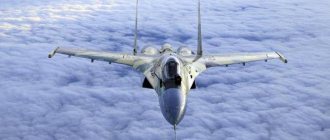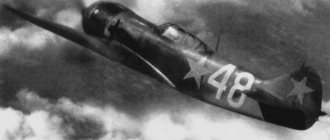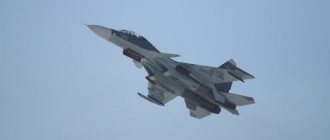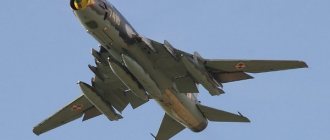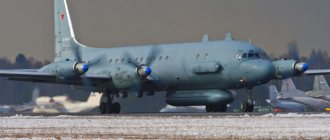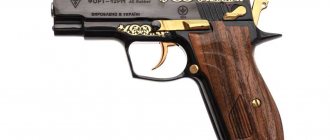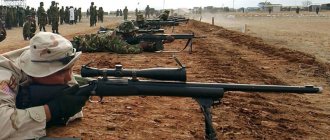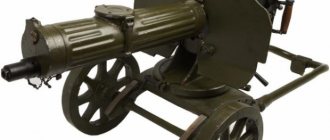The intense competition that exists between states in the field of military technology leads to the rapid obsolescence of military vehicles. Therefore, the period of maintenance of military aircraft in service is quite short.
First of all, this problem applies to fighters designed to counter the latest enemy models. But everywhere there are exceptions. The MiG-21 aircraft, a brilliant achievement of Soviet designers, was supplied to the aviation fleet of the USSR and other countries for more than a quarter of a century.
History of creation
The Soviet MiG-15 fighter, which showed itself to be a formidable weapon in Korea, greatly upset American pilots and the US leadership, dispelling the idea of the backwardness of Soviet aviation. In the current situation, the geopolitical enemy of the USSR urgently needed a machine that could surpass Soviet aircraft in its combat characteristics.
In 1954, the world's first fighter, the speed of which exceeded sound speed by 2 times, the Lockheed F-104 Starfighter, took off into the airspace.
The Russians' goal was to counter the Americans with an aircraft capable of intercepting high-speed bombers and destroying enemy attack aircraft.
In the early 60s, in accordance with the Resolution of the Council of Ministers of the USSR, design bureaus began to work on the creation of a fundamentally new type of machine - a supersonic attack aircraft.
The design bureaus of A. Yakovlev, P. Sukhoi, A. Mikoyan and M. Gurevich were involved in the process; they all worked on separate projects.
Yakovlev presented the Yak-140 - a light fighter, distinguished by good thrust-to-weight ratio and great maneuverability in the vertical and horizontal planes.
Having relied on maneuverability, the designers had to sacrifice speed. This decided the fate of the project: it was rejected.
The SU-7, developed by a group led by Sukhoi, was put into production and produced from 1957 to 1960. It had the following characteristics:
- Thrust-to-weight ratio max: 3900 kgf: 7370 kg = 058 (afterburner mode - 0.78);
- Wing load = 7370 kg: 23 sq.m. = 320 kg/sq.m;
- Maximum speed – 2170 km/s;
- Maximum height – 19100 m;
- Good maneuverability, which follows from the parameters of thrust-to-weight ratio and specific wing load.
But due to significant flaws in the design of the machines, they often failed. In 1957, in accordance with the directives of the management, the Su-7 began to be converted into a fighter-bomber - the Su-7B (product S-22).
However, the MiG-21 was chosen as the front-line fighter, which later became the most popular attack aircraft in the history of the country. It was easier to operate, more economical in terms of fuel consumption, and less noticeable in the air. Its takeoff and landing characteristics exceeded those of the Su-7.
Prototypes for MiG-21
The time for close maneuver battles was ending. The attack aircraft was designed to conduct combat attacks when aircraft approach each other at enormous speeds and hit the target with the first missile salvo. The supersonic aircraft of the opponents, Lockheed F-104 in America and Mirage 3C in France, were designed using the same principle.
From the beginning of 1957, A. Brunov was appointed chief designer, who should manage the entire work process (design, construction, testing, finishing of experimental machines).
- E-1 - the first fighter model from the MiG-21 family had a swept wing. A separate engine was developed for it, but did not meet the deadline;
- E-2 is the second prototype with the AM-9B engine from the MiG-19 and a swept wing. Maximum speed 1700 km/h. The E-2A with the new engine accelerated to 1900 km/h;
- E-4 - this model was created simultaneously with E-2. The wing shape is triangular. Engine AM-9B. The sophisticated design of the multi-mode air intake allowed the vehicle to reach a speed of 700 km/h more than the MiG-19. Although in both cases the same engine model was used. The rationality of using a delta wing with a sweep of 57° along the leading edge was also proven by flight results. The maximum speed was 2000 km/h. In the course of further development, the vehicle was modified to version E-6. She reached speeds of up to Mach 2. The E-6 became the prototype of the production MiG-21.
How to turn Bulgarian scrap metal into fighter jets
But the story connected with the MiG-21s purchased from Ukraine turned out to be even more fun. Four of the five aircraft failed almost immediately. When Croatian investigators began to find out what was wrong with the fighters, it turned out that a Ukrainian company had purchased them in Bulgaria. The decommissioned MiG-21s, which spent the last five years literally in a landfill, were purchased by Ukrainians “for spare parts.” At the same time, the Bulgarians also distinguished themselves - in their report sent to NATO, the sold MiGs were listed as “disposed of”.
The Bulgarian aircraft scrap metal brought to Ukraine was creatively modified - the numbers on the units were changed, false documentation was drawn up, and then solemnly handed over to the Croatian Air Force.
By the way, according to Croatian experts, the two engines and many units installed on the planes have nothing to do with the Bulgarian MiG-21 - it seems that the masters of Ukrspetsexport carried out a “shopping” through all the aircraft landfills on the planet.
Article on the topic
Economy of Ukraine: from a space power to a territory with a set of resources
MiG-21, design description
The aircraft is a single-seat mid-wing aircraft, equipped with one engine. Built according to a normal aerodynamic configuration, it has a low-lying delta wing (sweep 57° along the leading edge), all-moving horizontal tail (keel and rudder) with high sweep.
The wings are equipped with ailerons and flaps. Aerodynamic ridges to increase the lateral stability of the aircraft at high angles of attack. The wing consists of 2 consoles with one spar. The consoles have 2 fuel tanks.
In total, the fuel system, depending on the version of the car, included 12–13 tanks.
Fuselage type: semi-monocoque, i.e. part of the loads is carried by the fuselage, the other part of the loads is distributed to the load-bearing elements of the frame - stringers and frames. All-metal construction made of aluminum and magnesium alloys.
The cross-sectional shape is elliptical. The engine is separated by a steel fire partition in the rear section. The air intake (a mechanical device that receives air to cool the engine and equipment) is located in the nose of the aircraft.
A movable cone-shaped device with a radio sight antenna was placed in the air intake; in addition to placing the antenna, the cone regulated the direction and strength of the air flow directed into the engine.
At subsonic and low supersonic flight speeds - up to M = 1.5, the cone was inside the air intake device. From M=1.5 to M=1.9 it occupied the middle position. When reaching values above Mach 1.9, the cone moved forward. The air channel bifurcated, surrounding the cockpit with the pilot, and then connected again.
Anti-surge doors are equipped on the sides of the fuselage in the nose of the fighter to prevent surge. The radio-electronic equipment was placed in front of the cabin, with a section of the landing gear underneath it. The chassis is three-post with a nose support.
The main supports are in the wing niche and fuselage. The brake system is pneumatic. The tail section of the aircraft is equipped with a compartment with a braking parachute.
The cockpit canopy has a teardrop shape with a small gargrot behind it.
It consists of a fixed visor and a folding part of the canopy; during ejection, the squibs tear off the hinges of the folding part, and the massive header of the chair knocks it out.
The cabin is sealed. The air enters it through a compressor, which compresses it, increasing the oxygen density to levels acceptable for breathing. The thermoregulatory device maintains the set temperature.
The pressurized cabin was equipped with a liquid anti-icing system for washing the glass surface. The armor on the vehicle was impressive: frontal armored glass, front and rear steel armor plates to cover the pilot. The pilot's seat is equipped with an ejection system - KM-1M.
Aircraft versions were improved, and in parallel, work was carried out on power plants - turbojet engines. MiG-21F, MiG-21P, MiG-21U were equipped with an afterburning engine R-11F-300 (first name AM-11), which significantly improved the performance of the vehicles.
Thanks to the PURT-1F engine control system, it was possible to regulate engine operation with just one lever.
Modifications
From version to version, the designers, relying on the results achieved and the experience of the pilots gained during air battles in Vietnam, improved the tactical and technical characteristics of the fighters.
The design of the forward part of the fuselage, the canopy, the dimensions of the garrot, radio electronics, the combat arsenal, and power plants were subject to changes.
First generation
The first generation is represented by the MiG-21F and MiG-21F-13 fighters.
| Version | MiG-21F (item 72) | MiG-21F-13 (product 74) |
| Years of manufacture | 1959–1960 | 1960–1965 |
| Engine | Fuselage turbojet R-11F-300 | Fuselage turbojet R-11F-300 |
| Engine characteristics | (1x3880/5740 kgf) | (1x3880/5740 kgf) |
| Equipment: optical sight, radio rangefinder | ASP-SDN, SRD-5 | ASP-5ND, SRD-5M “Kvant”, for reconnaissance purposes it was equipped with an AFA-39 photographic camera |
| Armament | 2 HP-30 cannons (30 mm, quantity of ammunition for 1 installation - 60), 16 NAR* S-5M or S-5K with a caliber of 57 mm, NAR ARS-240 (240 mm) or 2 bombs 50–500 kg. | 1 gun for 30 warheads, TGS K-13, blocks with S-5M missiles (16 or 32 pieces each), two PU-12-40 launchers for firing S-24 missiles, bombs or incendiary tank ZB-360 |
| Max speed indicators at altitude | 2125 km/h | 2499 km/h |
| ceiling | 19000 m | 19000 m |
*NAR – unguided aircraft rocket
Second generation
This generation is represented by a number of excellent combat vehicles.
MiG-21P (1960) - the first of the MiGs equipped with a radar and Lazur command guidance devices. The guns were dismantled, as history will show, in vain. External suspension - K-13 missiles. In return, the use of unguided bombs or NURS units was allowed.
The MiG-21PF (1961) (item 76), an upgraded version of the interceptor, was conceived as a lightweight all-weather aircraft. The power plant is represented by one engine, significantly strengthened compared to previous models.
Armament - S-5M or S-5K missiles and aerial bombs of caliber from 50 to 500 kg on an external sling. The MiG aircraft provided for the use of NUR missiles of the S-24 type, used by aviation to destroy enemy equipment and manpower.
MiG-21PFS (item 94) (1963) - a serial combat aircraft with improved takeoff and landing performance. Thanks to the modernized design, it became possible to operate aircraft from unpaved airfields, which, according to the instructions, had to meet fairly strict requirements.
Improved development has made it possible to reduce mileage and reduce landing speed.
It was possible to install accelerators to reduce the take-off distance.
MiG-21R (1965) - version designed for aerial reconnaissance. Under the fuselage, in replaceable containers, technical equipment for day, night and radio-technical aerial reconnaissance was placed: cameras for aerial photography, radio-technical and night-time devices, stations for jamming, intercepting and transmitting communications in the VHF range. Electronic warfare devices were used.
Third generation
The history of the creation of third-generation fighters is connected with the use of the new Sapphire-21 radar sight, which received the production number RP-22S. In terms of its technical parameters, the device far surpassed earlier models.
"Sapphire-21" made it possible to detect bomber-type targets at a distance of 30 km. The target tracking range was increased by 5 km, now it was 15 km.
The result of this technical breakthrough was an increase in the probability of a missile hitting a maneuvering target and the possibility of using missiles with a semi-active homing head.
Targets were illuminated, and the missiles automatically performed maneuvers. Fighter tactics have undergone significant changes.
Representatives of the 3rd generation:
MiG-21S (1965) - a machine with an increased fuel reserve and improved flight characteristics thanks to the new AP-155 autopilot system, which allows the aircraft to be brought into a horizontal position from any spatial position, stabilized course, and automatically taken away from a dangerous height.
MiG-21SN (1965) – front-line fighter, carrier of an atomic bomb.
MiG-21SM (1968) - an aircraft with improved take-off characteristics, an improved version of the MiG-21S. It differs from the latter in the engine model, which has more power.
The experience gained in Vietnam showed the need to equip combat aircraft with air cannons. Therefore, the fighter’s armament was supplemented with a double-barreled GSh-23L with 200 rounds of ammunition.
MiG-21SMT is an interceptor fighter, a modified version of the MiG-21SM. Distinctive qualities: increased fuel reserve, R13F-300 engine with an additional thrust boost mode (for example, the afterburner thrust increased at H=0, M=1.0 by 1900 kgf).
Missile and cannon weapons were installed: double-barreled GSh-23L for destroying ground and air targets, homing air-to-air missiles K-13 for attacking targets at long distances or short-range missiles R-60, R-60M, tactical atomic bomb RN25 .
Specifications
MiG-21bis (1972) - the last production version. This fourth-generation aircraft is recognized as the most advanced of all 21 MiGs. They were equipped with photo and electronic devices for reconnaissance purposes.
- Wing span – 7.5 m;
- Dimensions, L×H – 14.10×4.71 m;
- Vehicle weight – 5460 kg;
- Normal take-off weight – 8726 kg;
- Fuel weight – 2390 kg;
- The engine of the MiG-21bis jet aircraft is a turbojet with an R-25-300 afterburner with a thrust force increased to 7100 kgf and high-altitude PD (1 pc.);
- Unforced thrust – 1×69.60 kN;
- forced – 1×97.10 kN;
- Max speed at altitude – 2175 km/h;
- Max ground speed – 1300 km/h;
- Range with external fuel tanks – 1470 km;
- Max climb rate – 13500 m/min;
- Max altitude of actual use – 17800 m;
- Max exp. overload – 8.5;
- Number of pilots – 1 person.
Technical equipment:
- Radar sight "Sapphire-21";
- Optical sight ASP-PFD-21;
- Automatic system control unit SVU-23ESN;
- Navigation and landing system RSBSN-5S.
Weapon:
- Double-barreled 23-mm cannon GSh-23L, b/c – 200 rounds;
- Short-range air-to-air guided missiles (up to 4) UR K-13M, RS-2US, R-ZS, R-ZR, R-60, R-6OM, NAR;
- Unguided and gliding bombs.
2013 cars of this latest modification were manufactured.
b 1963 TsNDS MU lHts-21ot SYARYUMNBHKH NOSHRMSHI PUDHNKNYUZHHNMMSHI OPKHZHEK "yaYuOTHP-21", YANGDYUMMSHI B mon "tyUGYURPNM" X ONKSVKHBKHI B YAEPKHIMNL OPNKHGBNDYARBE NANGMYUVEMH E on 22nd.YaRYUMZHK "YYUOTHP-21" OH YAYUBMEMHCH I OPEDEYARBEMMKHZHEI HLEKYU YASYYARBEMMSHE OPEHLSYYARBU. lNMNHLOSKEYAMSHI LERND OEKEMTSYUZHHH, KNTSYUPHTLHVEYAYHI OPHEL B YANBNYSOMNYARH I YUMYUKNL YNLOEMYUZHHH ANINBSHU KEOYARYINB NAEYAOEVHKH ITS BSHYANYSCH GYUYHYYYUMNYARE NR YUYRKHBM SHU H OYYAYAHBMSHU ONLEU. sDYUKNYAE GMYUVHREKEMN YAMKHGHRE BSHYANRS ANEBNTSN OPHLEMEMH KH SOPNYARKHRE KERVKHYS SYAKNBH NAMYUPSFEMKH X GYUBURYU JACKEYS.
oPH YANUPYUMEMHH REU FE STSKNB YAYYUMKHPNBUMH, VRN X S railway-30 (to-21) DUKEMNYARE NAMYUPSFEMKH JACKEYS RHOYU ANLAYUPKHPNBYKHY BNGPNYAKYU B ONKRNPYU PYUGYU X DNYARKHTSKYU 30 YL. nDMNBPELEMMN DUKEMNYARE YANOPNBNFDEMHЪ ZHEKEY SBEKHVHKYUYAE I 10 DN 15 YL. sBEKKHVEMKHE DUKEMNYARKH X GNMSH NAMYUPSFEMKH YANGDUKN SYAKNBKH DK ONBSHYEMKH BEPNЪRMNYARKH MYUBEDEMKH YYULNKERYU MU ZHEKE X NAYEOEVHKN BNGLNFMNYARE DK EE YURYUYKH MU P YUSPYYUU DN 3/4.
eYAKKH KERVKHY YAYULNKERYU-OEPEUBYURVHYU, NYAMYUYYMMNTSN YARYUMZHKHEI railway-30, OSYARKHB PUYERS pya-2-sya, BSHMSFDEM ASHK YANOPNBNFDYURE DN ONOYUDYUMKH B ZHEKE, RN pyuya "yaYuOTHP-21" KKHÉ "ONDYABEVKHBUKYU" OPNRKHBMKHYU, OPEDNYARYUBKHB PUYERE p-gp (y- 13p) I ONKSUYRKHBMNI PUDHNKNYUZHNMMNI TSNKNBYNI YAYULNMYUBEDEMKH (cyam) YAYULNI NOPEDEKRE RPYUEIRNPKHCH DBHFEMKH. nDMNBPELEMMN BNGPNYAKYU RNVMNYARE YARPEKEASH ON MUGELMSHL ZHEKL.
MNBYU pkya NAEYAOEVKHBUKYU B KCHASHU LERENSYAKNBKHU ONKHYAY X NAMYUPSFEMKHE BNGDSMSHU ZHEKEY B OEPEDMEI ONKSYATEPE, NONGMYUBYUMKHE TSNYASDYUPYARBEMMNI OPKHMYUDKEFMNYARKH, BSHANP ZHEKH , GUUBYUR X YANOPNBNFDEMKHE, BSBEDEKHE YYULNKERYU MU YPHBSCH OPKHZHEKHBYUMH, BSHVHYAKEMHE X KHMDHYUZHCH GNM BNGLNFMSH OSYAINB PUYER p-3ya X p-3p, NOYYAMSHU GNM YAAKHFEMKH KH TNPPLKHPNBYUMKHE YNLYUMD "OSYAY PYUGPEYEM" KH "NRBNNPNR". yPNLE SCHRNTSN pkya BN BGYUHLNDEIYARBHH I NORHVEYAYHL OPKHZHEKNL yuyao-ot-21 ONGBNKYU BEYARKH OPHZHEKEMSCH YARPEKEAS ON BNGDSMSHL X MUGELMSHL ZHEKL XG OSEY X MESOPIUBKELSHLH YUBHYUZHNMMSHLH PYYERYULH (mup). ON ANKENLS YAVERS pkya "YaYuOTHP-21" OPEBPYURHKYUYAE B YAHYARELS PYUDHNSOPYUBKEMKH BNNPSFEMHEL.
ONYARYUMNBKEMKHE OPYUBHREKEYARBU N YANGDYUMKHH MNBNI YAKHYARELSH BNNPSFEMHYASHKN ONDOKHYUMN BEYAMNI 1962 TsNDYU KH MU ShchRS PYUANRS NRBNDHKNYAE VSRE ANKEYE RPEU KER. nDMNBPELEMMN lya "bSHLOEK" OPEDOKHYASHBYUKNYAE PYUGPYUANRYURE PUYERS y-13l YKYUYAYU "BNGDSU-BNGDSU" I REOKNBNI tsam X SBEKHVEMMNI DUKEMNYARECH YARPEKEASH.
YNMYARPSYRKHBMN YOOYUPYURSPYU po-22ya BSHONKMEMYU B BHDE YNMREIMEPYU, ME BSHUNDHBIETSN GYU NABNDSH OKUMEPYU HYARPEAHREK.
GYUBNDYAYKHE KERMSHE HYAOSHRYUMKH NOSHRMNTSN YAYULNKERYU, ONKSVKHBETSN NANGMYUVEMHE lHts-21ya
(GYUBNDAYNI No. 0725) MYVYUKKHAE B YNMZHE 1963 TSNDYU. b YAKEDSCHYEL TsNDS Y MHL OPKHYANEDHMKHKHYAE EY DBY YYULNKERYU No. 95210101 X No. 95210102, OPHVEL MU ONYAKEDMEL HG MHU B NVEPEDMNI PYUG SBEKHVHKH OKNYYUDE YHK. nRPYUANRYU YUY "YYUOTHPYU", RYU KH SOPUUBKELSHU PUYER GYURMSKYUYAE KH GYUBEPHKYUYAE, YNCDU ONKSHUYUK ONFYUP BNIMSH BN BEERMULE. bNGLNFMN, ShRN NAYARRNREKEYARBN KH YARYUKN TSKYUBMNI OPKHVKHMNI GYUOSYAYU OEPEUBYURVKHYU B YAEPKHIMNE OPNKHGBNDYARBN, ME DNFKHDUYAE NYNMVYUMKH ETSN TsNYASDYUPYARBEMMSHU HYAOSH RYUMHI.
b NRKHVHE NR lHts-21ot, MU LHts-21ya, YPNLE pkya "yaYuOTHP-21", SYARYUMNBHKH MYYKYUDMNI RNOKHBMSHI AYU ANKEYEI ELYNYARKH, OND YPSHKNL DNAYUBHKH EYE DBYU SGKYU ONDBEYAYKH BNNP SFEMKH, GYUKHLARBNBUB KHU NR lHts-21p. REOOPE KHYARPEAHREKE LNTs MEYARKH NDMNBPELEMMN ON DBE PUYERSH p-3ya X p-3p. yPNLE SCHRNTSN, DNOSYAYUKYUYAE ONDBEYAYU MESOPIUBKELSHU PEYURKHBMSHU YAMYUPDNB H ANLA B PUGKHVMSHU YNLAKHMYUZHKHU, B GYUBKHYAHLNYARKH NR ONYARYUBKEMNI GYUDYUVKH. MU SHCHRKHU FE SGKYU LNTSKKH ONDBEBKHBUREYA KH DBYU DNONKMHREKEMSHU RNOKKHBMSHU AYUYU (ME YAVKHRYU ONDTCHGEKFMNTSN). yYUY X MU lHts-21otl, OND TCHGEKFEL PUYAONKYUTSYUKYUYAE TsNMDNKYU tso-9 I DBSUYARBNKEMNI OSYNI ts-23, OPEDMYUGMYUVEMMNI DK AKHFMETSN LYUMEBPEMMNTSN AN H ONPYUFEMKH MUGELMSHU JACKEYS.
UNRЪ, ON YAPYUBMEMHCH I OPEDEYARBEMMKHYNL, lHts-21ya GYULERMN ONRJFEKEK, NM ON-OPEFMELS NYAMYUYUKYA DBHTSUREKEL p11t2ya-300. oPUBDU, ASHKYU OPEDSYALNRPEMYU GYULEMYU rpdt ANKEE LNYMSHL p13-300 I SBEKHVEMMSHL B ONKRNPU PYUGYU GYUOYUYANL TSYUGNDHMYULHVEYAYNI SARNIVKHBNYARKH. p13-300 NRKHVYUKYA ME RNKEIN ONBSHYEMMNI MYUDEFMNYARECH, MN X OPNYARRNNI NAYAKSFKHBYUMKH, LHPNYHL AEYAYARSOEMVURSHL DHYUOYUGNMNL PEFHLNB "TNPYAYuF" I OKYUBMSHL HGLEMEMKH EL RYTSKH. MNLKHMYUKEMYU ROTSIU DBKHTSUREK YANYARYUBKYU 3400 YTSYA, Yu MU OPBNL TNPIYUFMNL PEFHLE - 6600 YTSYA, SDEKEMSHI PYYAUND RNOXBYU MU MNLKHMYUKE - 0.91 YTS/YTSYA, I SUYU LYUYAYU - 1134.6 yts.
nAMNBKHKNYAE ME RNKEIN OKHKNRYuFMN-MYUBKHTSYUZHHNMMNE, MN X YAOEZHHYUKEMNE NANPSDNBYUMKHE. MUOPHLEP, BLEYARN YPEMNBNTSN YUBRNOKHKNRYU ONYARYUBKHKH yuo-155, ONGBNKKBHI ME RNKEIN YANUPYUMRE ONKNFEMKHE LYUKHMSH NRMNYAHREKEMN RPEU NYAEI, MN X OPKHBNDKHRE EE Y Ts NPHGNMRYUKEMNLS ONKERS XG KCHANTSN ONKNFEMKH I ONYAKEDSCHYYYARYUAHKKHYUZHHEI BSHYANRSH YSPYU. yaRYUMZHKH yaon-10 OPEDSOPEFDYUKYU ON NAKSVEMHKH YAYULNKERYU PUDHNKNYURNPNL OPNRHBMKHYU, YU GEPYUKYU B YYUAHME SKSVIHKH NAGNP GYUDMEI ONKSYATEPSH. yYURYUOSKERMNE YPEYAKN yl-1 (yay-3) NAEYAOEVHBUKN YAOYUYAEMHE KERVHYU BN BYAEL DHYUOYUGNME YAYNPNYAREI H BSHIANR, BYKCHVYU BGKER H ONYUDYS. SYAKHKEMMYU OEPEDM YARNIYU KH SBEKHVEMMYU AYUGYU GYUDEKYKH rnyu YULNPRKHGYURNPYU NYAMNBMSHU NONP YUYAYAKH, GYUYKHRYU PJDU SGKNB KH YANEDKHMEMKHI NR GYUTSPGGMEMKHYU, YU RUYFE BMEM TSEPLERKHGYUZHH KCHYNB TCHGEKKFYU NAEYAOEVHBYUKH LYUYANBSCH SHYAOXYURYUZHCH YYULNKERNB DUFE I LYUKNONDTSNRNBKEMMSHU TsPSMRNBSHU YUSCHPNDPNLNB. bMEDPEMKHE ANKEE YANBEPYEMMSHU YAPEDYARB MUGELMNTSN NAYAKSFKHBYUMKH YAYULNKERYU GMYUVHREKEMN YANIPYURKHKN ONDTSNRNBYS ETSN Y ONBRNPMNLS BSHKERS.
KERMSHE HYAOSHRYUMKH lHts-21ya MYUVYUKHYAE B 1964 TsNDS, KH B YAKEDSCHYEL FE TsNDS TsNPEINBYAYKHI YUBKHYUZHNMMSHY GYUBND BSHOSYARKHK OEPBSHE 25 YAEPHIMSHU LYUHM (RHO “95”).
cru:
| lNDHTHYUZHH | lHts-21ya |
| pYUGLUU YPSHKYU, L | 7.15 |
| dKKhMYu, L | 14.10 |
| bSHYANRYU, L | 4.71 |
| OKNYYUDE YPSHKYU, L2 | 23.00 |
| OSYARNTSN YYULNKERYU | |
| MNPLYUKEMYU BGKERMYU | 8150 |
| RNOKHBU | 2320 |
| RHO DBKHTSUREK | 1 rpdt p-11t2ya-300 |
| rtsyu, ytsya | 1 U 6175 |
| LYUYAKHLYUKEMYYAINPNYARE, YL/V | |
| MU BSHIANRE | 2230 |
| WITH GELKH | 1300 |
| oPUYRHVEYAYU DUKEMNYARE, YL | |
| AEG ora | 1240 |
| I'm an ora | 1610 |
| oPUYIRKHVEYAYKHI ONRNNKNY, L | 18000 |
| lyuYa. SHYYAOXYURYUZHNMMMYU OEPETSPSGYU | 8 |
| schYHOYUF | 1 |
| bNNPSPHEMHE: | 23-LL OSYU ts-23k VERSHPE sp i-13 HKKH p-gya XKH pya-2sya INMREIMEP I 23-LL OSYNI ts-23 HKKH os mup i-24 |
| bottom. KhMTNPLYUZHKH: |
| vEPREF «lHYNYM,tsSPEBHV lHts-21 (1) » VEPREF "lHYNЪM,tsSPEBKhV lHts-21 (2)" yARYURE "lHts-21 B bbya xMDHH" yARYURE "lHts-21 OPNRKhB "lKHPYUFYU" yARYURE "aNEBYU OYUKHRPYU lHts-21 B eTSHORE" yYURE Kommersant "noEPYUZHKH" oEMKHZHKKKHM" (sTsNM lHts -21)" | lHts-21ya |
| lHts-21ya | |
| lHts-21ya | |
| lHts-21ya | |
| YuPYAEMYUK lHts-21ya | |
| yUAHMYU OHKNRYU lHts-21ya |
IWELSH:
| yaUUELYU ONDBEYAYKH BNNPSFEMHЪ lHts-21ya |
bYUPHYUMRSH NYPYYAYH:
| lHts-21 bbya yayap |
| YaOHYANY HYARNVMKHYNB: |
| mKHYNKYUYYSANBHV. hYARPEAHREKE lHts-21. ONYAKEDMHE LNDHTHYUZHHH yPSHKE PNAYAHH. KHYARNPKH YAYULNKERSHNYA "LKhts" yPSHKEЪ pNDHMSH. eTHL cNPDNM. pNFDEMKHE DNATSNFHREK ETHL cNPDNM, bKYUDHLHP yKHLNB. lHts-21 yPShKEЪ pNDHMSH. sch.schCEMASPTS. yaBEPUGBSINBNI PEYURKHBMSHY "lHts" hyARNPKH YNMYARPSYZHHI YAYULNKERNB B yayap 1951-1965TsTs. Famous Russian Aircraft. Yefim Gordon, Dmitry Kommisarov, Keith Dexter. Mikoyan MiG-21 Squadron/Signal. Aircraft Number 131. Don Linn, Don Spering. MiG-21 Fishbed in Action PKL. MiG-21 |
sTSNKNY MEAYU. 2011
Combat use
For the first time in military operations, the MiG-21 fighter was used in the Vietnam conflict (1966). The American F-104 Starfighter and Phantom were inferior to the supersonic Soviet attack aircraft in their ability to maneuver, especially in close battles.
The first aircraft from the 21 MiG family were not equipped with guns. The significance of this omission became clear almost immediately after the first battles, so the attack aircraft were equipped with cannon weapons. After firing rockets, the pilots used cannon fire.
The appearance of 21 MiGs in the Vietnamese skies in 1966 was a turning point, and peace negotiations began 2 years later. Military technicians call the Phantom a decent machine, but the fact is that this heavy interceptor is designed to defend aircraft carriers from supersonic fighters.
In 1971, aircraft from the MiG-21 family were used in the armed confrontation between India and Pakistan: the Indian aviation forces had several modifications of the supersonic attack aircraft in service.
The opponents used the J-6 (Chinese version of the MiG-19), the French Dassault Mirage III, and the American F-104 Starfighter. Enemy losses in aircraft were twice that of India.
In the Arab-Israeli conflict of 1973, MiGs were opposed by the Mirage III and F-4 Phantom II. The losses of Egypt and Syria were significantly lower than those of the Israeli side.
It is worth noting that Soviet attack aircraft were inferior to French aircraft in flight range, radar capabilities, and visibility, but were superior in maneuverability.
In Afghanistan, aircraft of the MiG-21bis, MiG-21UM, and MiG-21R versions were used in combat operations.
When the United States and France acquired 4th generation fighters that were superior to the MiG-21 in a number of respects, the MiG-21 lost its superiority.
Interesting Facts
In 1963, when working on the MiG-21PF, designers attempted to install titanium skis in addition to the wheeled chassis in order to reduce the load when landing on a dirt airfield.
Later, test pilots recalled how the attack aircraft “sped with the wind through the mud,” while the trucks got stuck.
MiGs on skis were never released, but the idea was useful for the Su-7BKL.
The MiG-21 had several nicknames: Balalaika for the shape of its wings, Vesyoly for its relatively small size, Dove of Peace (first versions) for having only 2 suspensions.
Israeli intelligence became interested in the MiG-21; they wanted to get the plane from the Iraqi Air Force through a bribed pilot. An operation called “Penicillin” was developed (1966).
But the first attempt failed; instead of an advanced attack aircraft, the traitor brought an outdated Yak. Therefore, another Iraqi pilot was recruited.
A suitable opportunity did not present itself immediately, since the Russians, having calculated the possibility of hijacking, did not fill the fuel tanks completely, but only for training flights. In August, when long flights were planned, a traitor stole a car to Israel.
Perhaps, if not for these events, the situation in Israel’s war with the Arabs in 1967 would have been different...
“The quality of goods and services satisfies our partners from the EU and NATO”
The Croatian authorities periodically send reliable but outdated cars for modernization. And in 2013, the Ukrainian enterprise Ukrspetsexport won the tender for these works.
Under the terms of the contract, the Ukrainian side undertook to modernize 7 MiG-21s “for the Tactical Air Defense Air Force of the Republic of Croatia”, as well as to supply “another five refurbished MiG-21s, which are the property of the State Enterprise Odessaviaremservice”.
The contract value was then estimated at 10.5 million euros. General Director of Ukrspetsexport Dmitry Peregudov stated in 2013 that the success of Ukrainian gunsmiths in Croatia demonstrated that Ukraine firmly holds its position as a significant player in the arms market.
“The quality and cost of military goods and services provided by the Ukroboronprom State Concern and the Ukrspetsexport State Concern satisfy our partners from the EU and NATO. Ukraine intends to further develop military-technical cooperation with European countries. Thanks to the high potential of the domestic defense industry, even the massive propaganda campaign of our competitors could not shake our positions,” the Interfax-Ukraine agency quoted Peregudov as saying.
Article on the topic
Alien "Mriya". Ukraine sold the world's largest aircraft to China
Afterword
The latest modification of the MiG-21bis was strikingly different from previous versions for the better. Combat equipment was increased in weight and arsenal. On the suspension, for example, it was possible to place up to 10 hundred-kilogram bombs, UB-32 and other weapons.
Thanks to the automatic sight, it was possible to fire at the enemy even under overload.
The MiG-21bis, being a fighter, gave a head start to fighter-bombers and did an excellent job of destroying ground targets. Even now, the legendary MiG-21 aircraft are in service in a number of countries - this is a characteristic that speaks better than all others.
More about the aircraft
Design engineers, when developing a military aircraft, made several upgrades to the first models. Thanks to this work, scientists were able to collect scientific information regarding the development of military equipment, which turned out to be invaluable.
The modernization of the MiG-21 helped the designers create a military aircraft with excellent technical and flight characteristics, capable of carrying a full set of weapons and successfully hitting the enemy from the air, practically without revealing its location. The modern fighter was able to demonstrate the above characteristics in practice, taking part in almost all military operations taking place in different parts of our vast planet.
